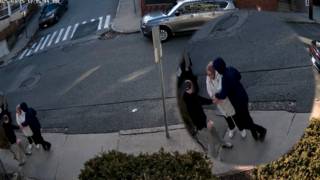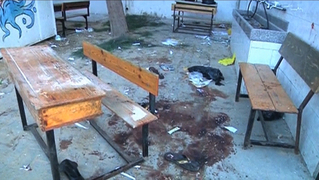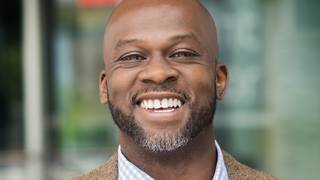
Guests
- Belal Daboura medical doctor that works at Shifa Hospital in Gaza City. He recently wrote an article for The Electronic Intifada website titled “The Boy Who Clung to the Paramedic: The Story Behind the Photo.”
We are joined from Gaza City by Dr. Belal Dabour of Shifa Hospital, the largest in Gaza. Dabour describes how Shifa has been stretched beyond capacity since the Israeli military assault began on July 8, struggling to treat thousands of victims amidst frequent power cuts and outdated equipment. He also discusses the hopes of his Gazan patients that the current conflict will bring an end to Israel’s eight-year siege. “After eight years, life has become intolerable,” Dabour says. “People have no hope. They feel that the horizon for any prosperous future is [impossible] until the siege is lifted.”
Transcript
AMY GOODMAN: We return to Gaza City to talk to Dr. Belal Dabour. Dr. Dabour works at Shifa Hospital in Gaza City, the largest hospital in the Gaza Strip. It has only 11 beds in the emergency room and six operating theaters, which have been stretched beyond capacity since the Israeli military assault began on July 8th. Shifa medical staff have been struggling to treat thousands of injured despite frequent power cuts and often outdated equipment. Dr. Belal Dabour recently wrote a piece for The Electronic Intifada headlined “The Boy Who Clung to the Paramedic: The Story Behind the Photo.”
Welcome to Democracy Now! Why don’t we start off on the effects of the Beit Hanoun U.N. school, that was a shelter, being shelled, 16 people killed, hundreds wounded? Have you seen any of those who were wounded at Shifa, Dr. Dabour?
DR. BELAL DABOUR: Yeah, this accident happened—this attack happened while it was my day off. However, the medical sources confirmed the death of 16 civilians. This is not the first attack of the kind. This is the attack number four in just four days which targeted U.N.-run school. And also these four days, about three attacks targeted hospitals and medical centers. Sixteen people died. That only just few, because yesterday more than 100 were killed.
AMY GOODMAN: Dr. Dabour, can you talk about, overall, the situation in Gaza and how you’re operating at the hospital?
DR. BELAL DABOUR: The Shifa Hospital is the largest hospital in Gaza Strip. It’s the hospital with the specialty centers. Doctors there are striving to deal with the cases. The staff has been divided into three teams, each team taking 24-hour shifts and then resting for about 48 hours, depending on the situation. Twenty-four/seven for 19 days now, there are casualties and bodies arriving at the hospital. The staff are stretched. The situation is very bad.
Let me speak about the night—last Sunday morning, when the Shejaiya massacre took place. Let me describe the scene at the operation room, for starting. At the operation room, six rooms were operating at the same time. The whole blood bank was moved to the theater, to the hole. There was a worker with this big bag of blood bags and the plasma, and just sitting there and distributing blood bags to the theaters, from number one to number six. And this continued all day long. A lot of people died inside the theater, in addition to the 60 people already whose bodies have been taken from the scene and the dozens others that are estimated to be stranded under the rubble. This is the Sunday.
However, my latest shift was two days ago, and I ended my shift Thursday morning. And from 3:00 a.m. to 8:00 a.m., we received about five bodies in just five hours, in just one hospital. And also we received more than three dozen injuries, a lot of them children and one whole family. This is the situation. And the biggest problem is that it’s not getting any better. Day by day, it’s getting worse and worse. The numbers are including, and the medical supplies are shortening, the shortages increasing as we speak now.
AMY GOODMAN: Dr. Belal Dabour, can you tell us about the photo of the little boy clinging to the paramedic that has gone viral?
DR. BELAL DABOUR: Yeah. This boy was actually lucky, for two things. First of all, his injuries could have been very serious. He could have died immediately. But for some miraculous thing, he did not. Second of all, there was a photographer at the time, and he captured the right photo and in the right time. However, up until 12:00 a.m. yesterday, more than 200 children have been killed in just those 18 days, and more than 1,400 children have been wounded. Those were not very lucky to be caught on camera, and those of them who were caught on camera were not very lucky, by the dynamics of social media, to make their photos go viral. I just want to stress the point that this photo, it might be forgotten with time; however, this boy was lucky: At least some people will remember him for some time. But there are thousands. The misery of thousands is not being reported. The world is not hearing about them. They are just numbers. And we are not numbers.
This boy, as I wrote in my piece, he came to the hospital injured with massive shrapnels. He was agitated. He was caught up in a state somehow in the middle between being awake and asleep, because he was sleeping safely in his home, and suddenly his home was targeted. So, maybe he was in a dream or something, so he was like in the middle of hallucination, not completely aware of his surroundings. And that’s probably the reason why he kept screaming, “Bring my father! I want my father!” And that’s why he kept clinging to the paramedic and refused to let go. However, in order to save his life, we had to sedate him with some drug, and the doctors immediately operated on him. And just about this area, there was a shrapnel this big that has penetrated his neck about one or two centimeters away from a big vessel in this area. He was very lucky that this vessel was not hit.
I believe he survived. With all of the flow of casualties, I could not know neither his name or if he was united with his father or what was the fate of the rest of his family. I only saw three other of his brothers. Two of them are just below three years, and the other a teenager. Those should be fine now. But what happened to the rest of the family? Are they under the rubble? Or if they are uninjured, why they were not—why didn’t we see them at the emergency room? I am not aware. But maybe this is for the best, because a little mystery—people tend to like mystery. Some mystery to the story might make it stick in the memories for a little bit longer, before he gets forgotten with the massive amount of people killed here and the increasing numbers.
AMY GOODMAN: Dr. Belal Dabour, you are a doctor, but you are also a Palestinian living in Gaza right now. Can you describe your daily life?
DR. BELAL DABOUR: Our daily life is basically just sitting at the house waiting for the next to come. My area is now swarming with people who are taking shelter from the North Gaza. I live somehow closer to the west side of Gaza City. In my house, now there are currently three families, three uncles who evacuated from the north. This situation is the same for all of my neighbors. Therefore, you can find some life in the streets; however, from my house and to the east, the life is paralyzed. Only ambulances can pass through the streets. All aspect of life are paralyzed, of course. And in addition, this is in addition to the problems with electricity. Yesterday only 24 hours—only one hour per 24 hours, we had power supply; today, little less than three hours. And also, this is affecting the sewage pumping, and this is affecting the water supply. This situation is not in my area; it is in the whole of Gaza Strip.
Now I’m speaking, and behind me there are artillery shells falling on the area of al-Zeitoun, and to the right, the Shejaiya area is also, where the massacre happened, it’s still being bombarded at the moment. I’m speaking to you and hearing shells with my left ear. This continuous shelling has been nonstop for more than one week now. It started last Thursday, and now we are on Friday, so for eight days there are explosions nonstopping for 24/7.
AMY GOODMAN: What is the feeling of the Palestinian people in Gaza when the Israeli military says, if the rocket fire—if the Hamas rocket fire will stop, the thousands of rockets that are coming from Gaza, that they would begin to talk about a ceasefire? Is there support for the Hamas rockets stopping, Dr. Dabour?
DR. BELAL DABOUR: The Israeli side always try to sell the theory that this is a conflict between two states. However, we are not talking about a war between two states. We are talking about Gaza Strip, an area under occupation until now that is being besieged and bombed. And we are talking about Israel, a massive force with a extensive army and sophisticated weaponry, targeting such enclaved area, not only targeting them, but for eight years people have been deprived from all means to live. So, if you look at the situation this way, you will find that anything that comes from Gaza is a form of resistance, whether you agree with it or not. And this is what the people are saying.
Two days ago, when Khaled Meshaal, senior Hamas officer, he spoke and said that there will be no ceasefire unless there is lifting of the siege, I was at Shifa Hospital, and beside me were the families of the people who were injured—at the surgery department—who were injured from the Shejaiya massacre. And they kept screaming at Meshaal. They said that if he accepts, or if Hamas accepts that a ceasefire shall be achieved with no lifting of the siege, they will all start to be the enemies of Hamas, because they have lost everything, and they have no hope, so at least those sacrifices should not go to waste, should not go without the lifting of the siege. This is the minimum that the people have been asking. This is not what Hamas say. And if your correspondents just make a few interviews at the streets, I suspect that anyone will say otherwise.
AMY GOODMAN: And can you explain just the effect of this siege, what it is? In the United States, it is not as clear, when you talk about the siege, what the siege of Gaza means. When Israeli officials are interviewed, like, for example, Mark Regev, the spokesperson for the prime minister, when someone says Gaza being occupied, he says, “No, we left Gaza many years ago.”
DR. BELAL DABOUR: Well, he can say whatever he says, but the United Nations still treats Gaza as an occupied strip. By the siege of Gaza, your guest before me said that Gaza has been besieged for decades now. And this is true. But for the previous eight years, the siege has taken the forms—have taken many forms. For four years, until 2010, the siege meant that there was absolutely no movement outside of Gaza Strip and that there were shortages of electricity, shortages—Israel denied entry of medicines, denied entry of most types of food. Israel used to calculate how much calories each person in Gaza should allow, and that calculation was about 2,100 calories per person. And this was published in Ha’aretz.
However, now the siege is taking another smarter form. For example, now we can get whatever medicines we want, speaking about the health sector. But they put a ban on the unity government. They put a ban on the movement of finances to the Gazan banks. They also crush the economy so that internal revenues are now up to zero. And then they say, “You can have whatever medicines you want.” So the siege is continuous for eight years, but it’s taken many forms. However, one common manifestation of this siege is that now, after eight years, life has become intolerable, and people have no—they have no hope, and they feel that the horizon for any prosper futures for themselves or for the future is not seen, at least now, until the siege is lifted.
AMY GOODMAN: And if there is a ceasefire—you have, what, more than 2,600 homes that have been destroyed, thousands more that have been damaged. What happens if there’s a ceasefire?
DR. BELAL DABOUR: Yeah, let me tell you about the war in 2008. About 5,000 houses were completely destroyed. Those houses remained unbuilt, unreconstructed for about two years, until the tunnels solved some of the problem. Some construction materials started coming in through the tunnels. And then, after the tunnels started working and we started getting some construction materials, Israel allowed some other construction materials to get into Gaza through UNRWA. So for two years, people were staying at their relatives or at whatever shelter they could provide. This tragedy now, if the siege is not lifted, it shall be repeated again, and for God knows how long. It might continue forever until the siege is lifted, because now even the tunnels that were used to find temporary solution are gone by now.
AMY GOODMAN: You have a final comment, Dr. Belal Dabour. I’m seeing a tweet that’s coming right from the AP office where you are standing, overlooking Gaza City, that says large parts of Gaza City are now being shelled by artillery. Your final comment?
DR. BELAL DABOUR: My comment is that, as a doctor, if this situation was an illness, I would prescribe this medicine. As Dr. Mads Gilbert said, the best medicine is first, number one, stop the assault immediately; and, number two, stop the siege; and, number three, lift the occupation. But the most important now is for these massacres to stop, and number two is for the siege to be lifted, to allow the thousands of houses and the hospitals and the centers that were hit in this war, in addition to the previous inhumane circumstances, to allow them to be lifted at least. And then we can discuss number three, the lifting of the occupation. But number one, stop the killing immediately.
AMY GOODMAN: Dr. Belal Dabour, I thank you for being with us. I see that just behind your head there is smoke coming up. If you step—just shift aside, we will see what is directly behind you. That’s right. Dr. Belal Dabour, please stay safe—works at the Shifa Hospital in Gaza City. His piece at The Electronic Intifada called “The Boy Who Clung to the Paramedic: The Story Behind the Photo.”
That does it for the show. I’ll be speaking on Real Time with Bill Maher tonight on HBO, 10:00 Eastern Standard Time. Tomorrow night, I’ll be speaking on Martha’s Vineyard. Check our website at democracynow.org.












Media Options